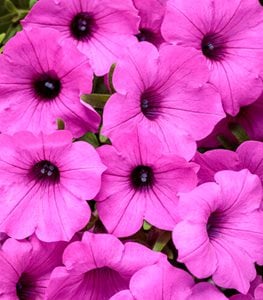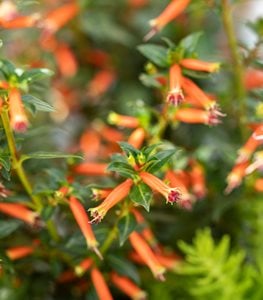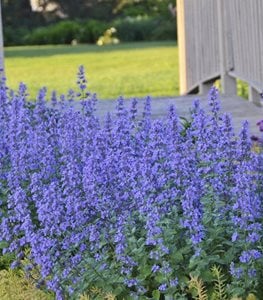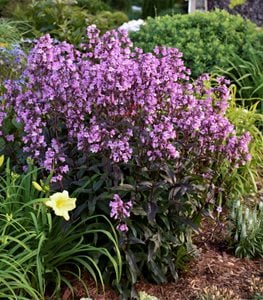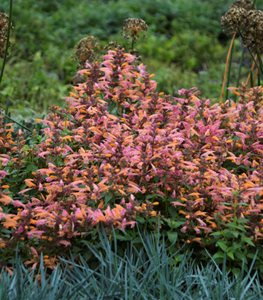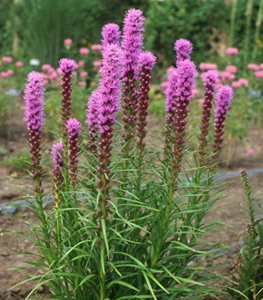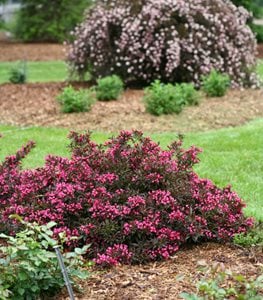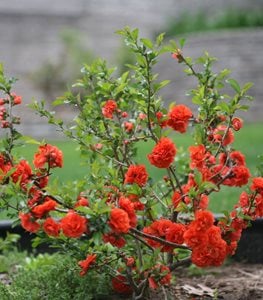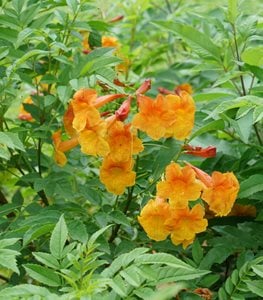Top 24 Flowers that Attract Hummingbirds
Invite these delightful creatures to your garden with some of our favorite hummingbird plantsIs there anything more magical than watching a hummingbird, seemingly suspended in midair, dip its long beak into a flower? Sometimes you’ll hear these tiny birds before you see them, their wings making a distinctive whirring sound. When two or more appear together, you may hear the sharp “chattering” as they swoop and dive in a series of aggressive, aerial maneuvers. It’s no wonder that gardeners love to encourage these remarkable acrobats into their gardens.
Fun fact: A single hummingbird can drink its entire body weight in nectar every day—fuel it augments with up to 2,000 tiny insects for protein (Cornell Lab of Ornithology).
What flowers do hummingbirds like?
Hummingbirds are primarily attracted to long tubular flowers that are red, but are frequently seen visiting other flowers with bright colors that are orange, yellow, purple, or even blue, giving you plenty to choose from. Keep in mind that many double-flowered forms aren't accessible to pollinators.
"Hummingbirds see in ultraviolet, so bold, iridescent blooms—think electric-purple petunias or vivid salvia—catch their eye instantly." — Welcoming Hummingbirds to Your Garden, Jenny, Creekside Nursery.
On this page: Annuals | Perennials | Shrubs and Vines | Design Tips | Hummingbird Feeder Tips
On this page:
- ANNUAL FLOWERS FOR HUMMINGBIRDS
- PERENNIAL PLANTS THAT ATTRACT HUMMINGBIRDS
- BUSHES AND VINES FOR HUMMINGBIRDS
- 5 QUICK DESIGN TIPS FOR A HUMMINGBIRD-FRIENDLY GARDEN
- HUMMINGBIRD FEEDER TIPS
Annual Flowers for Hummmingbirds
PETUNIA
Perhaps the most popular annual with gardeners, these are also a favorite of hummingbirds and bees with their large, trumpet-shaped blooms. The flowers are available in every color from white to black, including speckled, spotted, and striped varieties, as well as both single and double-flowered forms.
Zones:
Annual
Height/Spread:
6 to 10 inches tall and 10 to 30 inches wide
Plants to Try:
Supertunia® Vista® Jazzberry® (pictured), Crazytunia Mandeville, Surfinia Red
Learn more about growing petunias.
CALIBRACHOA
If you want the vibrant color punch of a petunia with even less maintenance, Calibrachoa, also called Superbells® and Million Bells®, may be the answer. Like their larger cousins, these are available in every color of the rainbow with both single and double flower forms. Choose from compact or trailing varieties.
Zones:
Annual
Height/Spread:
3 to 8 inches tall and 10 to 30 inches wide.
Plants to Try:
Superbells® Grape Punch™ (pictured), Cruze Yellow Red Eye, Million Bells Trailing Blue
Read more about how to grow calibrachoa.
CUPHEA
Include cuphea in all your summer designs if only to amuse children of all ages! Visiting hummingbirds will certainly add to the fun factor! Flower shapes include varieties that resemble the faces of tiny mice, as well as more traditional forms and elongated tubes. Tuck into hanging baskets, window boxes, and containers.
Zones:
Annual
Height/Spread:
8 to 28 inches tall and 12 to 24 inches wide
Plants to Try:
Vermillionaire® (pictured), Tiny Mice®, ‘Flamenco Samba’, Bat Face
Learn more about growing cuphea plants.
Perennial Flowers for Hummingbirds
CATMINT
Catmint (Nepeta spp.) has much to offer the gardener including long-lasting blooms, drought tolerance, and deer resistance, as well as aromatic foliage. Hummingbirds are also attracted to the tiny tubular lavender-blue flowers and enjoy the sheer abundance of blooms on each long flower spike.
Zones:
3-8
Height/Spread:
12 inches to 3 feet tall, 18 to 24 inches wide
Plants to Try:
‘Cat’s Meow’ (pictured), ‘Little Titch’, ‘Walker’s Low’
Read more about growing catmint.
SAGE, SALVIA
With both hardy and tender varieties of sage (Salvia spp.) available in shades of purple, blue, pink, and white, there are plenty of options. There is even a fabulous golden leaved pineapple sage, Proven Accents® Rockin® ‘Golden Delicious’ (pictured), that blooms late in the season with tubular red flowers.
Zones:
3-11
Height/Spread:
1-1/2 to 4 feet tall and 1-1/2 to 3 feet wid
Plants to Try:
Rockin® Fuchsia, Color Spires® ‘Indiglo Girl’, ‘Caradonna’
Learn more about growing salvia.
BEARDTONGUE, PENSTEMON
This long-blooming perennial is perfect for many design styles, including cottage garden, prairie, xeriscape, and rock gardens, with many shapes, sizes, and colors to choose from. There are even some varieties with deep purple foliage. Spikes of tubular flowers in red, orange, purple, or blue are favored by hummingbirds.
Zones:
3-9
Height/Spread:
1-1/2 to 4 feet tall and 1-1/2 to 3 feet wide
Plants to Try:
‘Midnight Masquerade’ (pictured), Firecracker, ‘Cha Cha Purple’
Read more about growing beardtongue.
BEE BALM
Ignored by deer and rabbits, yet a favorite of bees, butterflies, and hummingbirds. The pom-pom flowers of bee balm (Monarda spp.) each offer an abundance red, pink, or purple blooms in summer.
Zones:
4-9
Height/Spread:
10 to 48 inches tall and 10 to 28 inches wide
Plants to Try:
’Pardon My Cerise’ (pictured), ‘Jacob Kline’, ’Leading Lady Orchid’
Learn more about growing bee balm.
DAYLILY
Whether you are a serious collector or simply love the showy trumpet-shaped blooms, the hummingbirds will thank you for including them. Each flower may only last for a single day, but they are borne in large numbers over many weeks.
Zones:
3-9
Height/Spread:
1 to 6 feet tall and 1-1/2 to 2 feet wide
Plants to Try:
Rainbow Rhythm® ‘Ruby Spider’ (pictured), Rainbow Rhythm® ‘Tiger Swirl’, 'Flasher'.
Learn more about growing daylilies.
ANISE HYSSOP, HUMMINGBIRD MINT
Aromatic, drought tolerant, deer and rabbit resistant, the hyssop (Agastache ssp.) genus deserves a place in your sunny garden. Compact varieties work well in containers and hanging baskets, while mid-sized and taller selections mingle well in naturalistic, prairie-style designs. Flower colors include shades of red, orange, yellow, blue, and pink.
Zones:
5-9
Height/Spread:
8 to 54 inches tall and 8 to 30 inches to wide
Plants to Try:
Mango Tango (pictured), ‘Apache Sunset’, ‘Kudos Mandarin’
Learn more about growing hyssop plants.
GARDEN PHLOX
A classic cottage garden perennial, garden phlox (Phlox paniculata) is also a favorite of hummingbirds. The tall stems of fragrant flowers are popular with florists, while more compact selections ensure they can be enjoyed even as a container plant.
Zones:
4-8
Height/Spread:
12 to 48 inches tall and 12 to 36 inches wide
Plants to Try:
Luminary® 'Prismatic Pink' phlox (pictured), ‘Starfire’, Pink Flame®
Read more about how to grow phlox.
BLAZING STAR, GAYFEATHER
Bottle-brush flowers in violet or white are the hallmark of this popular deer-resistant perennial, their vertical form a welcome change from the more typical daisy shapes of the late summer border. The finely textured grassy foliage, ornamental in its own right, provides contrast to broader leaves.
Zones:
3-9
Height/Spread:
24 to 30 inches tall and 6 to 12 inches wide.
Plants to Try:
’Kobold’ (pictured), ‘Floristan Violet’
Read more about growing liatris.
CARDINAL FLOWER
Cardinal flower (Lobelia spp.) is a moisture-loving perennial that thrives in full sun (in northern climates) or partial shade and is both deer and rabbit resistant. Hummingbirds will fight over the tubular scarlet flowers which look especially dramatic on selections that have dark foliage. Varieties are available with flowers in shades of red, pink, and also white, all of which also attract butterflies.
Zones:
3-9
Height/Spread:
2 to 4 feet tall and 1 to 2 feet wide
Plants to Try:
Starship™ Scarlet Bronze Leaf (pictured), Starship Deep Rose
LUNGWORT
Plant several clumps of lungwort (Pulmonaria spp.) where you can see them from indoors, as they will be one of the earliest perennials to offer a source of nectar for your hummingbirds in spring. Sturdy stems hold small clusters of white, pink, or blue flowers high above the silver spotted leaves.
Zones:
3-8
Height/Spread:
8 to 12 inches tall and 15 to 18 inches wide.
Plants to Try:
'Spot On' (pictured), ‘Mrs. Moon’, ‘Diana Clare’.
CAPE FUCHSIA
While deer may not be interested, hummingbirds will flock to the trumpet-shaped flowers that come in a range of colors from hot pink, vivid orange, and salmon, to creamy yellow and pure white. These grow well in average soil, are semi-evergreen in milder climates, and reasonably drought tolerant once established.
Zones:
7-9
Height/Spread:
2 to 3 feet tall and 1-1/2 to 2 feet wide
Plants to Try:
‘Moonraker’, ‘Sunshine’, ‘Magenta’
Shrubs and Vines for Hummingbirds
WEIGELA
Early summer blooms cover the shrub in shades from palest pink to a true red, and foliage that may be variegated, green, gold, or a rich plum. Small spaces can take advantage of newer compact varieties, while larger landscapes will appreciate the many taller options available. Weigela thrive in full sun and average soil, are drought tolerant once established, and rarely bothered by deer.
Zones:
4-8
Height/Spread:
2 to 6 feet tall and 3 to 5 feet wide
Plants to Try:
Spilled Wine® (pictured), Czechmark Trilogy®, My Monet®, Tuxedo™, Maroon Swoon®
Learn more about growing weigela.
OREGON GRAPE
Pacific Northwest homeowners are often delighted to discover Anna’s hummingbirds overwintering in their garden, when the blooms of Oregon grape (Mahonia spp.) are an important food source. This evergreen shrub has holly-like leaves and yellow shuttlecock-type flowers in winter, followed by edible blue berries. Preferring partial shade, these do well even in dry soil.
Zones:
5-ll
Height/Spread:
12 inches to 10 feet tall, 2 feet to 8 feet wide
Plants to Try:
‘Charity’, ‘Arthur Menzies’, ‘Soft Caress’, creeping mahonia, ‘Marvel’
HARDY FUCHSIA
This flowering shrub is an easy-care addition to your hummingbird garden. Most are frost hardy and add a bold splash of color to a woodland garden or shady courtyard, especially if you select one of the varieties with golden foliage. A cold winter may kill the shrub to the ground, but it will quickly emerge in spring from the base.
Zones:
6-10
Height/Spread:
2 to 6 feet tall and 2 to 6 feet wide. Mature size and hardiness vary with variety.
Plants to Try:
‘Genii’, ‘Riccartonii’, ‘Beacon’
Learn more about growing fuchsia plants.
AZALEA
Few shrubs can rival azaleas for color in spring—a back-of-the-border showstopper or a compact reblooming evergreen foundation shrub. Azaleas thrive in acidic, moisture retentive, well-drained soil.
Zones:
3-10
Height/Spread:
3 to 6 feet tall and 3 to 5 feet wide.
Plants to Try:
Perfecto Mundo® series, Encore® series, ‘Northern Lights’ series, ‘Girard’ series
Learn more about growing azaleas.
FLOWERING CURRANT
Possibly one of the easiest shrubs to grow, this drought tolerant, deer resistant, deciduous, native plant (western United States and Canada) attracts hummingbirds by the dozen—so be sure to place this large shrub where you can enjoy the early spring display of flowers. Suitable for open shade or sunnier locations.
Zones:
6-8
Height/Spread:
3 to 10 feet tall and 3 to 10 feet wide
Plants to Try:
‘King Edward VII’, ‘Elk River Red’, ‘Pokey’s Pink’
FLOWERING QUINCE
Flowering quince (Chaenomeles speciosa) makes a bold statement in early spring, each branch studded with clusters of small rose-like blossoms. There are new, thornless, and more compact varieties available that could even be used in a container garden. Flower colors range from palest pink to deepest crimson.
Zones:
5-9
Height/Spread:
4 to 8 feet tall and 3 to 8 feet wide
Plants to Try:
Double Take® Orange, ‘Texas Scarlet’, ‘Toyo-Nishiki’
Learn more about flowering quince.
YELLOW BELLS, ESPERANZA
A large shrub that can be used for screening or boundary planting, yellow bells (Tecoma stans) is native to the southern United States through South America. Many homeowners prefer the newer, more compact hybrids. Hummingbirds love the yellow, orange, or apricot blooms. These shrubs need regular water and full sun to thrive.
Zones:
8-11
Height/Spread:
3 to 25 feet tall and 3 to 20 feet wide
Plants to Try:
Chicklet® Orange (pictured), ‘Orange Jubilee’, ‘Gold Star’, ‘Sierra Apricot’
Learn more about growing esperanza plants.
TRUMPET VINE
This fast-growing vine needs to be grown on a large, sturdy structure to support its considerable weight. The species may also sucker profusely, which in addition to its self-seeding tendencies has resulted in it being declared invasive in some areas (check with your local extension office before planting). Plant in full sun and average to lean soils.
Zones:
4-9
Height/Spread:
25 to 40 feet tall and 5 to 10 feet wide
Plants to Try:
Flava, Balboa Sunset®, ‘Atropurpurea’
TRUMPET HONEYSUCKLE
Trumpet honeysuckle (Lonicera sempervirens) is native to the eastern U.S. and does not produce an abundance of seed, like Japanese honeysuckle. Easily grown in average soil with the best flower production in full sun. Fragrant flowers are followed by red berries that several birds enjoy. Primary bloom time is late spring with sporadic flowering until fall. Depending on the climate, may be deciduous, semi-evergreen, or evergreen.
Zones:
4-9
Height/Spread:
8 to 20 feet tall and 3 to 6 feet wide
Plants to Try:
‘Dropmore Scarlet’ (pictured), ‘Magnifica’
Learn more about growing honeysuckle vines.
CYPRESS VINE
An annual in colder climates, a re-seeding perennial in more temperate regions, and considered an invasive weed in southeastern U.S., cypress vine (Ipomoea quamoclit) is a twining vine with delicate, feathery foliage and tubular, star-shaped red blossoms that hummingbirds love. Train up a trellis or similar stricture when young. Check with your local extension office to see if this is invasive in your area.
Zones:
6-10, or enjoy as an annual
Height/Spread:
10 to 15 feet tall and 6 to 10 feet wide
5 Quick Design Tips for a Hummingbird-Friendly Garden
- Layer the canopy. Combine tall nectar towers (penstemon, salvia) with mid-height bloomers (bee balm, agastache) and low edging plants (petunia, calibrachoa) so birds can feed at multiple heights without crowding.
- Stagger the seasons. Include plants with staggered bloom times to keep nectar flowing from spring through frost. Early: catmint and lungwort | Summer: bee balm and daylily | Late: agastache and pineapple sage.
- Group by color. Mass at least three plants of the same red or orange tubular variety to create bold “landing zones” that hummingbirds spot from afar.
- Add open airspace. Leave a 2- to 3-foot gap between clumps or paths so birds have clear flight corridors and you get unobstructed viewing from a bench or window.
- Tuck in essentials. A shallow bubbler fountain for quick sips, a few dwarf conifers for perching, and several small one-port feeders spaced apart complete the habitat without inviting territorial squabbles.
What About Using Hummingbird Feeders?
Feeders can help—if you mimic nature. Cornell researchers note that hummingbirds are fiercely territorial because, in the wild, a depleted flower may force them to fly far for their next sip. That instinct carries over to feeders, so you’ll satisfy more birds by hanging several small, one-port feeders in different spots rather than a single jumbo model (Cornell Lab of Ornithology).
Keep each feeder immaculately clean and refill every 2-3 days in warm weather to prevent the sugar solution from fermenting (cloudy nectar can be fatal). If maintenance sounds like a chore, simply plant more of the flowers listed above—no scrubbing required, and you’ll avoid inviting ants and wasps.
Learn more about feeding hummingbirds from the Audubon Society.
ABOUT THE AUTHOR
Karen Chapman is an award-winning garden designer, speaker, and author based in the Pacific Northwest. Raised in England “with a trowel in her hand,” she now creates four-season, deer-resistant plant combinations and shares her expertise through national magazines, workshops, and three bestselling books.
RELATED:
Hummingbird Haven
30 Essential Plants for Pollinators
Flowers for Bees
Best Flowering Shrubs
Native Plants - How & Why to Grow Natives

